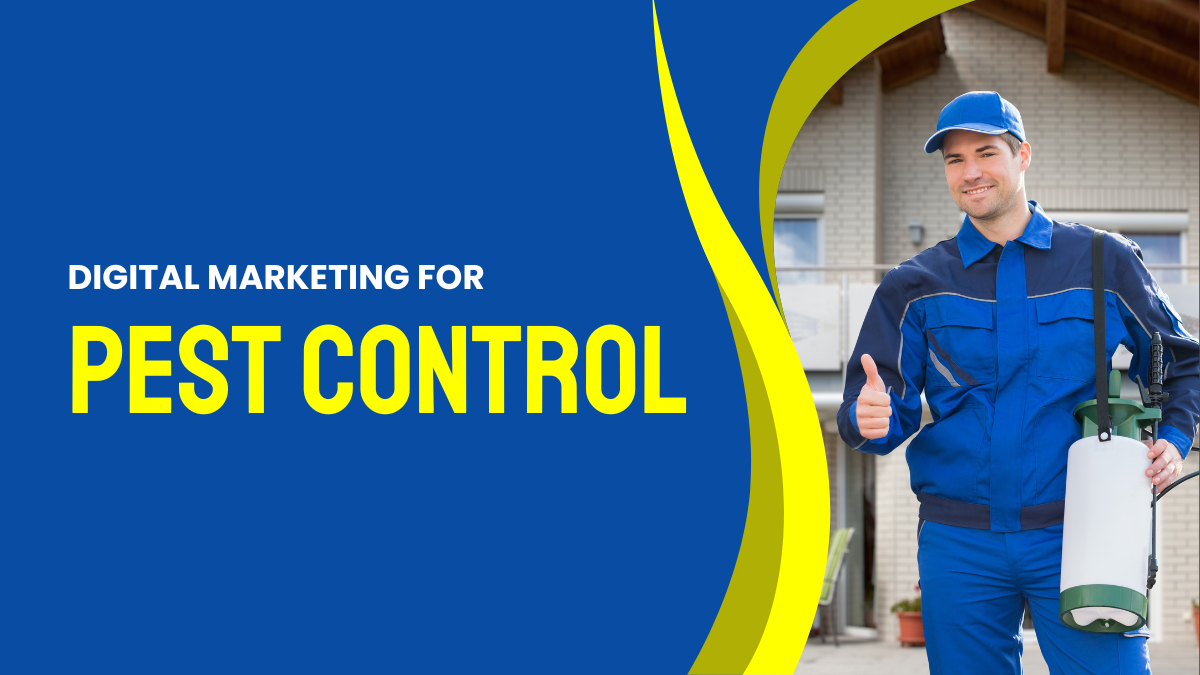
Digital Marketing for Pest Control
Is your phone ringing as much as you’d like with new customers needing pest control services? If not, the answer might not be in your trucks or your traps, but online. Many pest control business owners are experts at handling termites, rodents, and ants but feel lost when it comes to websites and social media. The good news is, you don’t need to be a tech wizard to make digital marketing work for you.
This guide is designed for business owners just like you. We’ll break down digital marketing into simple, understandable pieces, share real stories, and introduce easy, practical ideas you can act on. You’ll learn the key strategies that get your business noticed online, how to put them into practice, extra tools for maximum impact, and see how others have found success. Let’s get your business in front of the customers who need you right now.
Why Your Pest Control Business Needs to Be Online

Think about the last time you needed a local service. Did you flip through a phone book? Probably not. You likely pulled out your phone and searched online. That’s exactly what your potential customers are doing when they discover a pest problem. They’re searching for “exterminator near me” or “best pest control for ants.” If your business doesn’t show up, you’re invisible to them.
Digital marketing is all about making sure you appear in those search results. It’s about being present where your customers are looking. For a service as urgent as pest control, being easy to find online isn’t just a bonus—it’s essential for growth. It helps you build trust, reach more local homeowners, and keep your schedule full.
Did You Know?
According to recent studies, almost 90% of consumers search online to find local businesses. For pest control companies, this means that a strong online presence can mean the difference between a phone that rings all day—and one that’s silent.
Key Digital Marketing Strategies for Pest Control

Let’s explore the most effective ways to market your pest control business online. You don’t have to do everything at once. Start with one or two and build from there.
1. Local Search Engine Optimization (SEO)
SEO is the process of making your website more attractive to search engines like Google. When someone in your town searches for pest control, you want your business to be at the top of the list. That’s what good SEO does.
Why it works: SEO targets customers who are actively looking for your services. They have a problem and need a solution now, making them highly qualified leads.
Practical Tips:
-
Claim Your Google Business Profile: This is the single most important step for local SEO. It’s a free profile that lets you appear in Google Maps and the local search results. Fill out every section completely: your business name, address, phone number, hours, and services. Add real photos of your team, your vehicles, and what makes your company unique.
-
Focus on Local Keywords: Think about what people type into Google. They probably use phrases like “pest control in [Your City]” or “termite inspection [Your Town].” Use these phrases naturally on your website, especially on your homepage, about page, and each service page.
-
Get Customer Reviews: Encourage happy customers to leave reviews on your Google Business Profile. Positive reviews build trust and help Google see your business as a reputable choice. Respond to every review, even negative ones—polite, helpful replies show you care about customers.
-
Optimize for Mobile: More and more people are searching on their phones. Make sure your website is mobile-friendly so visitors can call, message, or book your service easily from any device.
Example in Action
After updating their Google Business Profile and adding customer photos, “HomeGuard Pest Services” started showing up in Google’s top 3-pack for local searches. Within a year, they saw a 40% increase in calls, all thanks to simple yet powerful SEO tweaks.
2. Pay-Per-Click (PPC) Advertising
PPC ads are the sponsored results you see at the very top of a Google search page. With platforms like Google Ads, you bid on keywords, and you only pay when someone clicks on your ad.
Why it works: PPC gives you immediate visibility. While SEO takes time to show results, a PPC campaign can start sending traffic to your website the day you launch it. It’s perfect for targeting customers who need emergency pest services or for launching a new service or seasonal promotion.
Practical Tips:
-
Bid on keywords like “emergency exterminator” or “rodent removal same day.” People searching these terms are ready to buy—right now!
-
When someone clicks your ad, send them to a dedicated page on your website (a landing page). This page should have a clear headline, a simple form to fill out, and your phone number in a prominent spot. Consider adding a live chat bot for immediate customer questions.
-
Google allows you to add a clickable phone number right on your ad for mobile users. This can drive more phone calls, especially from customers with urgent needs.
-
You have complete control over how much you spend. Start with a small daily budget to see what works, and you can adjust it as you go. Track which keywords bring calls and new jobs, and focus your budget there.
Example in Action
A company called “EcoGuard Pest Eliminators” started a summer PPC campaign targeting “mosquito control [City Name]”. For every $1 they spent, they brought in $7 in new business over two months. With regular tweaks and careful tracking, PPC became one of their main sources of fast leads.
3. Social Media Marketing
Platforms like Facebook and Instagram are not just for sharing family photos. They are powerful tools for connecting with your local community and building brand awareness.
Why it works: Social media allows you to show the human side of your business. You can build trust and stay top-of-mind, so when a follower has a pest problem, your company is the first one they think of.
Practical Tips:
-
Post tips on how homeowners can prevent common pests. Create short videos showing how you safely handle wildlife or identify different bugs. This positions you as the local expert.
-
Facebook’s ad platform is great for targeting specific neighborhoods or demographics. You can run ads offering a seasonal discount or promoting a new service to people right in your service area.
-
Post before-and-after photos of a job well done. Share pictures of your friendly technicians (with their permission, of course). Introduce your staff with fun “meet the team” posts. People buy from people they trust.
-
Answer questions, respond to comments, and join neighborhood groups. This builds community goodwill and spreads your name by word-of-mouth—digitally.
Example in Action
“Town & Country Pest Solutions” ran a short video on Facebook showing how to safely remove wasps from a porch. The video was shared by dozens of local residents and brought in 10 new customer leads the very next week.
4. Email Marketing
Email marketing is a way to stay in touch with your past and potential customers. It’s an effective tool for generating repeat business and referrals.
Why it works: You’re communicating with an audience that already knows you. It’s far easier to sell to a previous customer than to find a new one. Regular emails keep your business on their radar.
Practical Tips:
-
Add a “Sign up for our newsletter” form to your website. Collect emails from new customers when they book a service (always ask for permission). Another easy way: run a contest or giveaway for a free pest inspection in exchange for an email entry.
-
Send an email in the spring reminding customers about ant season or a fall email about rodent-proofing their homes. Include helpful, quick tips to show you’re a true industry expert.
-
Reward your loyal subscribers with a special discount or a priority booking offer. Announce new services or “refer-a-friend” specials to your email list so they feel like VIPs.
Example in Action
“SafeHome Pest Control” sends a short, friendly newsletter each month with pest prevention tips, spotlight stories of solved cases, and discount codes only for readers. Their repeat customer rate increased by 35% over twelve months!
5. Content Marketing
Content marketing means creating and sharing valuable information to attract, educate, and win over customers. For pest control companies, this could include blog posts, guides, infographics, or FAQs on your website.
Why it works: Content not only improves your website’s Google ranking, but also builds trust. When people feel you’re willing to share your knowledge, they’re more likely to call you when they need help.
Practical Tips:
-
Start a Blog: Publish articles like “10 Common Signs of Termites” or “How to Keep Mice Out of Your Home.” Choose topics people actually search for. Answer the questions you hear most from customers.
-
Use Images and Infographics: Visual elements catch attention and make information easier to digest. Consider a “pest calendar” infographic showing seasonal activity in your area.
-
Be Consistent: Posting just once a month can make a big difference. Share your articles on social media to expand your reach.
Example in Action
“Suburban Shield Pest Control” wrote a blog post about “What Attracts Ants to My Kitchen?” and shared it online. That single post brought hundreds of new website visitors each month, and several said they booked after reading it.
6. Video Marketing
Video is quickly becoming one of the most engaging ways for businesses to reach new audiences. People love watching short, helpful how-tos or seeing local experts in action.
Why it works: Video helps explain complex issues (like pest habits or prevention) in a simple, visual way. It builds personal connection—people feel like they know you before they even call.
Practical Tips:
-
Show the steps to identify bed bugs or explain how you perform a termite inspection. Keep videos brief—under 2 minutes works best.
-
Address common worries, such as “Are pest control treatments safe for pets?” This is a great way to put nervous customers at ease.
-
Post your videos on Facebook, Instagram Reels, and YouTube. Tag your city and business to get found locally.
Example in Action
“Downtown Pest Patrol” filmed technicians describing a day in the field and posted quick clips on Instagram Stories. They received messages from new clients who felt reassured by seeing the actual people who would visit their homes.
Real-World Success: Pest Control Businesses Winning Online
Consider a small, family-owned pest control company called “City Pest Pros.” For years, they relied on word of mouth and flyers. Business was steady but not growing. They decided to focus on just two digital strategies: a Google Business Profile and Facebook ads.
First, they claimed and fully optimized their Google profile, adding photos of their team and truck. They started asking every customer for a review. Within three months, they went from having zero reviews to over 30 positive ones. Their ranking on Google Maps shot up, and calls from new customers looking for local exterminators doubled.
Next, they ran a simple Facebook ad campaign in the spring, targeting homeowners within a 15-mile radius. The ad offered a discount on ant treatments. The campaign cost them $300 but generated over $4,000 in new business. By focusing on these simple, targeted efforts, they transformed their lead flow without needing a huge budget or technical expertise.
More Success Stories:
-
“BugFree Solutions” started a weekly pest prevention tip series on social media and saw their followers double in six months. Several customers said their posts helped solve small issues—and those customers referred friends for bigger jobs.
-
“All Seasons Exterminators” invested in a professional explainer video for their homepage. The video quickly became their top conversion tool, with website leads increasing by 50%.
Going Beyond: Tracking Results and Scaling Up

Implementing digital strategies is just step one. The next is keeping an eye on what’s working so you can spend time and money wisely.
Tips for Ongoing Success:
-
Track Your Calls and Leads: Use a simple spreadsheet, a CRM tool, or call tracking software to monitor where new customers are coming from (Google, Facebook, email, etc.).
-
Ask Every New Customer How They Found You: Make it part of your booking script. This helps you know which marketing channels deserve your focus.
-
Test and Improve: Try different ad messages, blog topics, or social posts. Notice which ones get the most attention, and do more of what works.
Final Thoughts
Feeling overwhelmed? Don’t be. You can start making a real impact with just a few focused steps. Here’s what you can do this week:
-
Claim and Complete Your Google Business Profile: If you do nothing else, do this. It’s free and is the foundation of your online presence.
-
Add a Contact Form to Your Website: Make sure your website has a simple form and a clearly visible phone number on every page.
-
Ask for Reviews: Make it a habit to ask every satisfied customer to leave a review on Google.
-
Write (or Film) Your First Tip: Publish one quick, helpful article or a 60-second video answering a common pest question in your area.
-
Choose One New Strategy to Focus On: Whether it’s posting weekly tips on Facebook, trying a small Google Ads campaign, or sending a seasonal email, pick one area and commit to it for a few months.
Digital marketing isn’t a magic button, but it is a powerful engine for growth. By meeting your customers where they are—online—you can attract more leads, book more jobs, and build a stronger, more profitable pest control business for the future.
30 minutes
Expert Consultation
Terms & Agreements
By booking a free 30-minute consultation, you agree to our terms, including scheduling, cancellation policies, and confidentiality. The session provides expert advice without guarantees of specific outcomes or results.






Leave a Reply
Your email address will not be published. Required fields are marked *